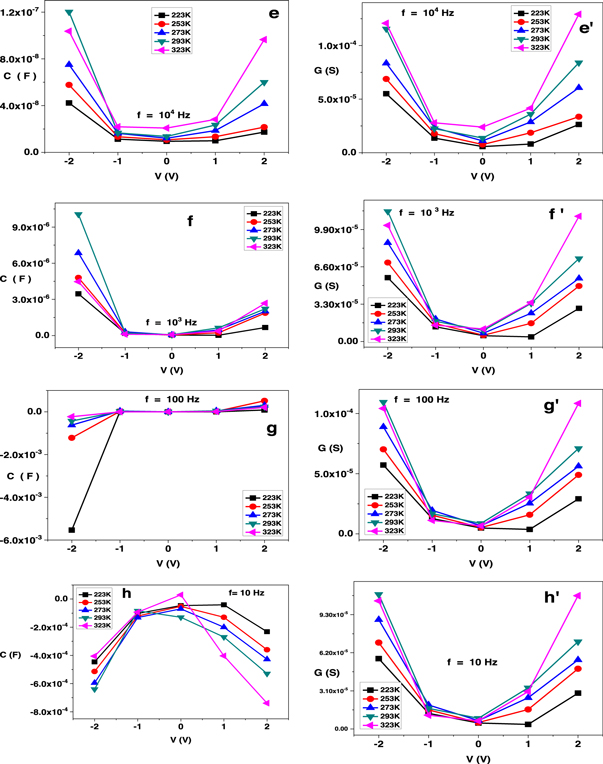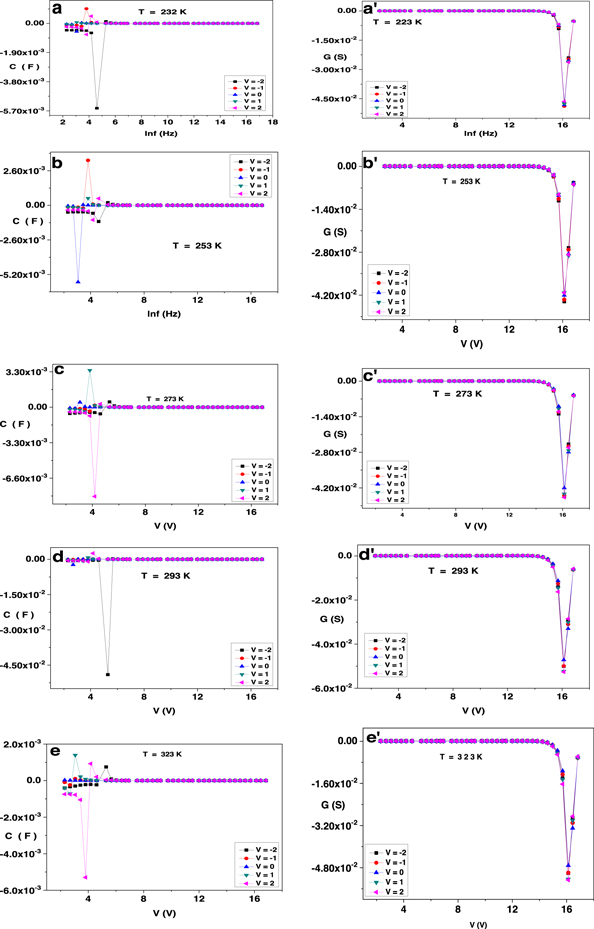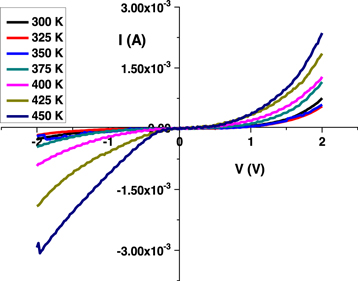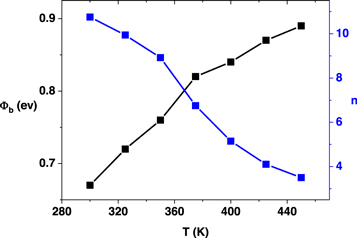Abstract
The paper presents a new approach based on the appearance of negative capacitance (NC) at high and low frequencies; previously, researchers agreed that NC only occurred at high or low frequencies. For the first time, we synthesized Au/polypyrrole/MWCNT composite/TiO2/Al2O3/n-Si/Al structure for use in electronic and supercapacitor applications. The structural, electrical, and dielectric properties were investigated by x-ray diffraction, FTIR, Raman spectroscopy, I-V, and C-V measurements. The results revealed that for all working voltages and temperatures, negative capacitance and conductance occurred at high frequencies between 2 × 107 and 107 Hz. Similarly, the phenomena of negative capacitance occurred at low frequencies (100, 10) Hz. The capacitance-voltage experiments were used to perform the analysis of the variation of capacitance and conductance with frequency, voltage, and temperature. The polypyrrole, MWCNT composite /TiO2/Al2O3/n-Si structure exhibits diode behavior and has a high rectification ratio. I-V measurements were used to investigate ideality factors, barrier height, series and shunt resistance#, and rectification ratio.
Export citation and abstract BibTeX RIS

Original content from this work may be used under the terms of the Creative Commons Attribution 4.0 licence. Any further distribution of this work must maintain attribution to the author(s) and the title of the work, journal citation and DOI.
1. Introduction
Multifunctional materials have attracted considerable interest due to their special and combined properties, such as electrical, mechanical, biochemical, and thermal. Since these materials can be employed in a variety of fields, including energy storage, catalysis, drug delivery systems, sensors and biosensors, and as an antiseptic substance in medicine. Supercapacitors are considered one of the energy storage devices, which has experienced rapid growth over the last few years due to a variety of benefits including extended cycle life, reversibility, and environmental friendliness, particularly advanced energy density (E) and power density [1]. Supercapacitors can be employed in a variety of applications, such as portable electronic devices [2], electric vehicles, and telecommunication [3]. The suggestion of conducting polymers through multiwall carbon nanotubes has opened new frontiers to obtain composites possessing the properties of both materials which have great potential applications such as supercapacitors [4, 5], actuators [6], biosensors [7], and electromagnetic shielding [8]. Among conducting polymers, polypyrrole has been widely used as composites with carbon nanotubes [9], owing to its superior properties such as high conductivity, good stability, and easy preparation [10]. In this effort, we report the fabrication of multiwall carbon nanotubes (MWCNTs) and polypyrrole (PPY)-MWCNTs nanocomposites. PPy can be simply manufactured in both ways: electrochemical [11] and chemical [12]. The deposition of conducting polymers and their composites on versatile flexible surfaces is commonly made by porous materials [13, 14]. Furthermore, tuning electrical, chemical, and mechanical properties of the PPy and its derivatives can be completely changed by a combination of the polymeric matrix with nanoparticles [15, 16], carbon nanostructures [17], and many other types [18]. Recently, composites with high electrical conductivity have desirable interest due to their potential applications in a variety of areas, including mobile systems, sensors, and actuators. Metal composites, MWCNT, CNTs, and conducting polymer nanoparticles are only some of the other available materials. So far, there has been insufficient research on MWCNT/polypyrrole composites. The paper presented a novel structure of MWCNTs/PPy composites/TiO2/Al2O3/n-Si, which hasn't been investigated before. For the first time, we have synthesized polypyrrole–MWCNT composite /TiO2/Al2O3/n-Si structure for use in electronic and supercapacitor applications. The structural, electrical, and dielectric properties were investigated by x-ray diffraction, FTIR, Raman spectroscopy, I-V, and C-V measurement. At high frequencies 2 × 107 and 107 Hz, the phenomena of negative capacitance and conductance have appeared in both, voltages and temperatures, similarly, NC appeared also at low frequencies (100, 10) Hz. Here presented a complete study of capacitance and conductance with frequency, voltage, and temperature. The ideality factor, barrier height, series and shunt resistance, rectification ratio were also studied.
2. Materials and methods
The Au/PPy-MWCNTs/Al2O3/TiO2/Al structure was synthesized by combining polypyrrole (PPy) and MWCNTs by mixing two emulsions made from PPy and MWCNTs, the source materials for PPy and MWCNTs were purchased from Sigma Aldrich with purity 99.9%. A thin film of aluminum oxide was deposited on the surface of the silicon by some droplets of its emulsion in water using a spin coater, a thin film of titanium dioxide was deposited onto the Al2O3 by the same process, and finally, some droplets of the composite of PPy-MWCNTs were placed on the surface of the TiO2 film, the structure after that became PPy-MWCNTs/TiO2/Al2O3. Two electrodes made of gold and aluminum were deposited on the upper and lower surfaces to measure electrical and dielectric properties. The Dielectric properties were measured in the frequency range 10 Hz to 20 MHz, temperature range from 223 to 323 K, and applied voltage from 2V to −2 V using a Novocontrol high-resolution alpha analyzer. We have developed advanced software that allows us to investigate the dielectric properties in detail at any temperature, voltage, or frequency. We input all the desired parameters and conditions then the program will calculate the dielectric properties.
3. Results and discussion
The surface topography of MWCNT-PPy/TiO2/Al2O3/Si thin film was examined using a Scanning electron microscope [19–23]. The diameter of MWCNTs is approximately 17.20 nm, as seen in figure 1(a). The MWCNT-PPY nanocomposite is seen in figure 1(b), the diameter of MWCNTs increases with the addition of polypyrrole. The regular diameter and length calculated using such data are between 363.2–463.6 nm. Figure 2 displays the XRD of MWCNT-PPY/TiO2/Al2O3/Si. The peaks are indexed as (002) and (100) diffraction planes, which approved the creation of PPy and MWCNTs. The peak at 25.5° was observed for pure PPy and MWCNTs, which have the same peaks. In addition to the peak at 25.5°, an additional peak at 43° was found, which is attributed to (100) reflection from MWCNT [24–27]. The peak intensity of (002) was relatively high in contrast with others. This higher intensity is attributed to the creation of high crystallinity and the precise alignment of the crystallites. Other peaks at 48.3°, 26.3°, and 11.5° were associated with TiO2, Al2O3, and Si, respectively.
Figure 1. (a), (b) SEM of MWCNTs-PPy/TiO2/Al2O3/n-Si.
Download figure:
Standard image High-resolution imageFigure 2. X-ray diffraction pattern of Au/MWCNT-PPy composite/TiO2/Al2O3/nSi/Al.
Download figure:
Standard image High-resolution imageFigure 3(a) displays the Raman spectrum of MWCNTs-PPy/TiO2/Al2O3/Si. The Raman spectrum of pure MWCNT had two distinct peaks: G band (1576 cm−1) and D band (1354 cm−1) as seen in figure 3(b). MWCNT/PPY nanocomposite processing transforms the D band to a large band in the Raman band. Furthermore, because of the presence of PPY, these D and G bands shift marginally after MWCNT was introduced into the PPY matrix, and one additional peak at 1057 cm−1 is observed, as seen in figure 3(a). This is due to the π – π contact between PPY and MWCNTs and the doping of PPY from the carboxyl group of functionally MWCNTs. TiO2 and Al2O3 were responsible for the peaks from 380 to 976.
Figure 3. (a), (b)Raman spectroscopy of Au/MWCNT-PPy composite/TiO2/Al2O3/nSi/Al.
Download figure:
Standard image High-resolution imageFigures 4(a–a', b–b', c–c', d–d', e–e', f–f', g–g', h–h') shows the capacitance and conductance as a function of temperature at different voltages and frequency of Au/PPy-MWCNTs/Al2O3/TiO2/Al structure. At a high frequency of 2 × 107 Hz, the capacitance and conductance decrease by steps with temperature to 295 K then raise in the same manner and take negative values as illustrated in figures (a), (a'). At frequency 107 Hz, the capacitance remains stable with temperatures up to 295 K, then disperses into positive and negative values, while conductance produces peaks for each voltage up to 295 K and then rises again, but its values are negative for all voltages and temperatures, as illustrated in figures 4(b, b'). At frequencies (106, 105, 104, 103) Hz, capacitance and conductance increase with temperature as shown in figures 4(c–c', d–d', e–e', f–f'), while at frequencies equal to 100 Hz, capacitance takes positive and negative values, although conductance increases with temperature as shown in figures 4(g, g'). At a low frequency of 10 Hz, capacitance decreases with temperature and only takes negative values, while conductance increases, as seen in figures 4(h, h'). NC denotes that the products have inductive properties [28]. NC phenomenon causes electron-hole recombination by local traps [29, 30], NC's dependence on frequency is compatible with bimolecular recombination, implying that trap conditions and/or contaminations in materials arbitrate electron-hole recombination [31, 32].
Download figure:
Standard image High-resolution imageFigure 4. (a–a', b–b', c–c', d–d', e–e', f–f', g–g', h–h') C, G versus temperature at different voltages and frequencies of MWCNT with PPy composite /TiO2/Al2O3/n-Si.
Download figure:
Standard image High-resolution imageFigures 5(a–a', b–b', c–c', d–d', e–e', f–f', g–g', h–h') reveals the capacitance and conductance as a function of voltage at different temperatures and frequencies for Au/PPy-MWCNTs/Al2O3/TiO2/Al. The capacitance and conductance at 2 × 107 Hz behave similarly, both have negative values as seen in figures 4(a, a'). Similarly, at frequency 107 Hz, C has both positive and negative values, while G only has negative values, as seen in figures 5(b, b'). At f = 106 Hz, the C only has positive values, and its values rise with increasing temperature; at low temperatures, the C decreases with voltage, while at high temperatures, the C increases in both negative and positive voltage regions [33], even though the conductance takes both positive and negative values, as seen in figures 5(c, c'). At f = (105, 104, 103) Hz, C, and G increased with temperature and increased in both the positive and negative voltage regions as seen in figures 4(d–d', e–e', f–f'). The C has negative and positive values at low frequencies (100 Hz), but only negative values at 10 Hz, though the G has the same performance as seen in figures 5(g'). The NC is exposed in several semiconductor products, including light-emitting diodes (LEDs) [34, 35], metal/insulator/semiconductor (MIS) [36, 37], Schottky diodes, metal/semiconductor (MS) [38–40], metal/polymer/semiconductor [41, 42], heterojunction [43, 44], detectors even in inorganic or organic semiconductor devices [45, 46]. The source of negative capacitance is attributed to the inductive conduct of the deliberate materials [47, 48]. Likewise, the accumulation region in the border can lead to the decline of the charge carriers at the electrodes [49]. The truthful description of the NC is providing by Zhu et al [50].
Download figure:
Standard image High-resolution imageFigure 5. (a–a', b–b', c–c', d–d', e–e', f–f', g–g', h–h') C, G versus voltage at different temperatures and voltages of MWCNT with PPy composite /TiO2/Al2O3/nSi.
Download figure:
Standard image High-resolution imageFigures 6(a–a', b–b', c–c', d–d', e–e') shows the capacitance and conductance as a function of frequency at different voltages and temperatures of Au/PPy-MWCNTs/Al2O3/TiO2/Al structure. As seen in figures, capacitance remains unchanged at mid and high frequencies, although it shows relaxation peaks at low frequencies with negative and positive values. The repaid decrease in capacitance creates relaxation peaks at a specific frequency. At this frequency, the capacitance changes rapidly from negative to positive values due to the saturation effect of deep and shallow trap levels at transition frequency. As the frequency increases, the retention time exceeds the period of ac signal hence, neither shallow nor deep level trap carriers respond to the driving voltage. Thus, the capacitance returns to positive values and approaches the geometrical capacitance of the sample. The lone current that prevails at this frequency is the displacement component produced by the charging of geometric capacitance. The C values were (1 × 10–3 to −5.5 × 10–3, 3.5 × 10–3 to 6 × 10–3, 3.7 × 10–3 to −9 × 10–3) respectively at low temperatures (232, 253, 273K). For all frequencies, the G remains stable, but at higher frequencies, the G decreases, and the peaks overlap, resulting in conductance having only negative values.
Figure 6. (a–a', b–b', c–c', d–d', e–e', f–f', g–g', h–h') C, G versus frequency at different voltages and temperature of MWCNT with PPy composite /TiO2 /Al2O3/nSi.
Download figure:
Standard image High-resolution image3.1. I–V characterization
I-V characteristic is one of the most widely used methods for determining the transport mechanism in diodes. The current in Schottky barrier diodes (SBDs) can be represented using the Thermionic Emission (TE) model as [42, 46, 51]:

Where I0 is given by

which can be determined from the interrupt of lnI versus voltage curvature. A is the effective area of the diode, A* is the Richardson constant of material and equal 112 A/cm2 K2 for n-type silicon [52, 53], T is the temperature, Φb is the barrier height, q is the charge of an electron, V is the voltage, k is the Boltzmann constant, n is the ideality factor, which can be calculated from the slope of current versus voltage curve through the relation [54].


n is a very significant factor that determines the diode behavior, the ideal diode has n = 1, and if n is greater than one, the diode exhibits non-ideal behavior [55, 56]. In common, in practice, n has a value greater than one. The high value of n can be credited to the presence of oxide thin film and series resistance Rs [57, 58], though, non-homogeneous Φb leads to a greater n value [59–61]. The higher n may be accredited to the existence of secondary mechanisms such as border dips and interfacial manufacture imperfections produced by an organic interlayer or a specific border assembly [62, 63].
Figure 7 displays the current-voltage characteristic of Au/PPy-MWCNTs/Al2O3/TiO2/Al at different temperatures, the structure shows a rectification behavior of a diode. Figure 8 reveals that the ideality factor decreases as temperature rises although the barrier height increases [64]. The higher values of n are attributed to the secondary mechanism interface, which results from the existence of two oxides layers between the composite of MWCNT with polypyrrole and Si [65, 66]. The ideality factors of the diode were determined from the I-V characteristic, its values are higher than unity (n > 10) due to the presence of an insulating layer between the semiconductor and metal [67, 68]. These factors induce a downward curvature in I-V plots with high forward biases, the downward curvature causes non-ideal behavior because of the presence of series resistance and interfaces due to thickness inhomogeneity. Barrier height inhomogeneity (BHI) causes abnormal electrical behavior in the Schottky barrier, when the barrier height fluctuates between low and high regions, it is considered an inhomogeneous barrier height and can be described using a Gaussian distribution [69]. The Gaussian model described by Werner and Güttler was used to explain the results [70, 71]. The temperature-dependent of ideality factor (n) and Schottky barrier height (Φb ) can be explained by local variations in the Schottky barrier height (Φb ) around the mean barrier height (Φb0(mean) ), where the reverse current increases with annealing to reduce the effective barrier height. When the temperature rises, the electrons have sufficient energy to overcome the higher barrier, so the result of the Φb will increase depending on the temperature and the bias voltage. Similarly, variation of Φb and n with temperature frequently produced surface defects in the border and high interface state density due to border defects, and non-irregularity doping concentrations. [72, 73]. Table1 summarizes different parameters as n, Φb, Rs, and Rsh which are obtained from the I-V characteristic curve.
Figure 7. I-V of MWCNT with Au /polypyrrole composite /TiO2/Al2O3/n-Si/Al.
Download figure:
Standard image High-resolution imageFigure 8. Ideality factor and barrier height versus temperature of MWCNT with Au /polypyrrole composite /TiO2/Al2O3/n-Si/Al.
Download figure:
Standard image High-resolution imageTable 1. The electrical parameters of MWCNT with Au /polypyrrole composite /TiO2/Al2O3/n-Si/Al.
| Rsh (Ω) | Rs (Ω) | Φb (eV) | n | T (K) |
|---|---|---|---|---|
| 3.5 × 106 | 5.95 × 104 | 0.67 | 10.75 | 300 |
| 3.3 × 106 | 5.72 × 104 | 0.72 | 9.94 | 325 |
| 1.05 × 106 | 5.64 × 104 | 0.76 | 8.92 | 350 |
| 1.81 × 105 | 1.21 × 104 | 0.82 | 6.75 | 375 |
| 7.8 × 104 | 1.08 × 104 | 0.84 | 5.15 | 400 |
| 4.73 × 104 | 9.55 × 103 | 0.87 | 4.1 | 425 |
| 4.08 × 104 | 1.74 × 103 | 0.890 | 3.5 | 450 |
Figures 9, 10, 11 show a decline in Rs and Rsh as temperature rises, indicating that the electrons have enough energy to overcome the barrier height. Figure 12 shows that as the ideality factor increases, the barrier height decreases due to the presence of titanium and aluminum dioxide within MWCNT with polypyrrole composite and silicon substrate, as well as the highest values of series resistance [74, 75].
Figure 9. Series resistance versus temperature of MWCNT with Au /polypyrrole composite /TiO2/Al2O3/n-Si/Al.
Download figure:
Standard image High-resolution imageFigure 10. Shunt resistance versus temperature of MWCNT with Au /polypyrrole composite /TiO2/Al2O3/n-Si/Al.
Download figure:
Standard image High-resolution imageFigure 11. Series and shunt resistance versus temperature of MWCNT with Au /polypyrrole composite /TiO2/Al2O3/n-Si/Al.
Download figure:
Standard image High-resolution imageFigure 12. Barrier height versus ideality factor of MWCNT with Au /polypyrrole composite /TiO2/Al2O3/n-Si/Al.
Download figure:
Standard image High-resolution imageFigures 13 and 14 show how junction resistance and rectification ratio change with voltage and temperature. We can figure out the value of series, shunt resistance, and rectification ratio from these diagrams.
Figure 13. Junction resistance versus voltage of MWCNT with Au /polypyrrole composite /TiO2/Al2O3/n-Si/Al.
Download figure:
Standard image High-resolution imageFigure 14. Rectification ratio versus voltage of MWCNT with Au /polypyrrole composite /TiO2/Al2O3/n-Si/Al.
Download figure:
Standard image High-resolution image4. Conclusion
In this paper, we manufactured Au/PPy-MWCNTs/Al2O3/TiO2/Al structure for use in electronic and supercapacitor devices. To our knowledge, the current structure has not been investigated before highlighting that one of the main advantages is the appearance of negative capacitance (NC) in high and low frequency. The structural, electrical, and dielectrically properties were explored by x-ray diffraction, FTIR, Raman spectroscopy, I-V, and C-V measurement. Negative capacitance and conductance were observed at high frequencies (2 × 107, 107 Hz) at both voltages and temperatures, and this effect was also observed at low frequencies (100, 10) Hz. A complete study of capacitance and conductance with frequency, voltage, and temperature, Ideality factor, barrier height, series and shunt resistance, rectification ratio were also studied. The greatest values of n are attributed to the secondary mechanism interface, which results from the existence of two oxides layer between the composite of MWCNT with polypyrrole and the substrate [76]. The ideality factor decreases as temperature rises, though the barrier height increases with raising the temperature. Rs and Rsh decline as temperature rises, the rectification ratio of this structure is very high.
Acknowledgments
Taif University Researchers Supporting Project number (TURSP-2020/84), Taif University, Taif, Saudi Arabia.
Data availability statement
All data that support the findings of this study are included within the article (and any supplementary files).

















